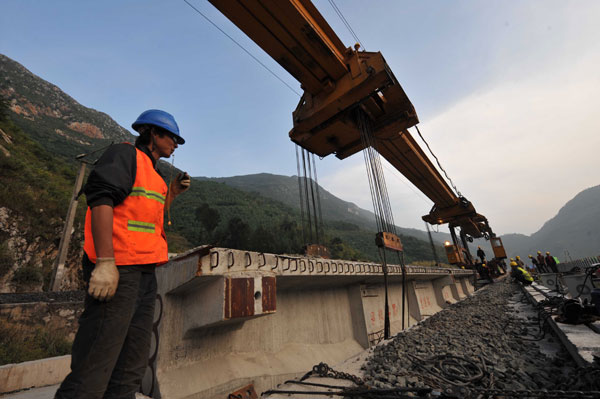GDP may slow for 9th quarter
17 January 2013
China’s economic growth is likely to slow for its ninth consecutive quarter in the period from July to September, top policy advisers said on Tuesday.
 |
|
A railway bridge under construction on the Liupanshui-Zhanyi line in Xuanwei, Yunnan province. The railway is expected to go into operation at the end of this year.CAO NING / FOR CHINA DAILY |
If their predictions prove true, the government may find itself taking “remarkable measures” to combat the slump, they said.
Zheng Xinli, deputy head of the China Center for International Economic Exchanges, a government think tank, said China’s economic data for August has turned out worse than expected and the economy’s prospects remain gloomy. Amid those circumstances,the country’s GDP is unlikely to grow at a faster pace in the fourth quarter.
“The urgent need right now is to clarify what are the most effective ways to boost domestic demand,” Zheng said.
He said growth can perhaps be best accelerated through expenditures on household goods, infrastructure, public utilities and modernized agriculture.
The dim economic indicators for August may push authorities to more aggressively fine-tune economic policy in the short term, economists said.
In August, the year-on-year growth rate for industrial output decreased to 8.9 percent, down from 9.2 percent in July. The August number was the lowest in the past 39 months, according to the National Bureau of Statistics.
Meanwhile, the country used 37.87 million metric tons of oil in August, down 1.5 percent year-on-year. That was the lowest monthly amount since September 2011, according to the New York-based energy and metals information provider Platts.
Song Yenling, senior analyst at Platts, said the decrease in demand results from the current economic slowdown and a reduction in industrial activity.
“The government’s stimulus policies will take effect in the second half, which will drive up the country’s oil consumption,” Song said.
Housing and automobile purchases will remain the twin pillars of the Chinese economy in the next decade or two, Zheng said, calling for steps to make real estate prices more stable.
The People’s Bank of China, the central bank, released a statement on its website on Tuesday, saying authorities will use various monetary policies to maintain a steady increase of credit and support the real economy, or the part of the economy related to goods and services.
“More attention will be paid to the new bailout and economic stimulus plans in the eurozone and the United States,” the statement said.
The central bank used reverse-purchase agreements on Tuesday to inject 290 billion yuan ($46 billion) into the financial system in an attempt at increasing cash liquidity in the short term.
It was the biggest single-day injection seen since 2004.
Zhang Liqun, a researcher with the Development Research Center of the State Council, said he expects China’s GDP growth to rebound in the fourth quarter, when the government’s previous policies begin to show their effects. “The rate for the whole year may remain between 7.5 and 8 percent.”
Last week, HSBC Holdings Plc released its preliminary Manufacturing Purchasing Managers Index, a gauge of manufacturing activity, for September. It showed a reading of 47.8, which was up from the 47.6 seen in August.
“That was the first macro data point for September and suggested that China’s economy may be starting to become more stable,” said Zhang Zhiwei, chief China economist at Nomura Securities Co Ltd.
He predicted GDP growth will increase slightly in the third quarter, going up to 7.8 percent. It was 7.6 percent in the preceding quarter.

Recent Comments